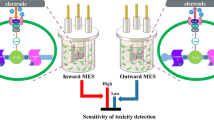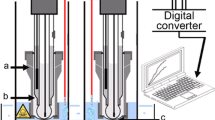Abstract
Toxicity assessment of water is of great important to the safety of human health and to social security because of more and more toxic compounds that are spilled into the aquatic environment. Therefore, the development of fast and reliable toxicity assessment methods is of great interest and attracts much attention. In this study, by using the electrochemical activity of Shewanella oneidensis MR-1 cells as the toxicity indicator, 3,5-dichlorophenol (DCP) as the model toxic compound, a new biosensor for water toxicity assessment was developed. Strikingly, the presence of DCP in the water significantly inhibited the maximum current output of the S. oneidensis MR-1 in a three-electrode system and also retarded the current evolution by the cells. Under the optimized conditions, the maximum current output of the biosensor was proportional to the concentration of DCP up to 30 mg/L. The half maximal inhibitory concentration of DCP determined by this biosensor is about 14.5 mg/L. Furthermore, simultaneous monitoring of the retarded time (Δt) for current generation allowed the identification of another biosensor signal in response to DCP which could be employed to verify the electrochemical result by dual confirmation. Thus, the present study has provided a reliable and promising approach for water quality assessment and risk warning of water toxicity.




Similar content being viewed by others
References
Chibwe L, Titaley IA, Hoh E, Sirnonich SLM. Integrated framework for identifying toxic transformation products in complex environmental mixtures. Environ Sci Technol Lett. 2017;4:32–43.
Noguera-Oviedo K, Aga DS. Lessons learned from more than two decades of research on emerging contaminants in the environment. J Hazard Mater. 2016;316:242–51.
Schwarzenbach RP, Egli T, Hofstetter TB, von Gunten U, Wehrli B. Global water pollution and human health. Ann Rev Environ Res. 2010;35:109–36.
Hoh E, Dodder NG, Lehotay SJ, Pangallo KC, Reddy CM, Maruya KA. Nontargeted comprehensive two-dimensional gas chromatography/time-of-flight mass spectrometry method and software for inventorying persistent and bioaccumulative contaminants in marine environments. Environ Sci Technol. 2012;46:8001–8.
Sun FH, Zhou QX. Metal accumulation in the polychaete Hediste japonica with emphasis on interaction between heavy metals and petroleum hydrocarbons. Environ Pollut. 2007;149:92–8.
Wang X, Gao NSJ, Zhou QX. Concentration responses of toxicity sensor with Shewanella oneidensis MR-1 growing in bioelectrochemical systems. Biosens Bioelectron. 2013;43:264–7.
Alves A, Kucharska A, Erratico C, Xu FC, Den Hond E, Koppen G, et al. Human biomonitoring of emerging pollutants through non-invasive matrices: state of the art and future potential. Anal Bioanal Chem. 2014;406:4063–88.
Murray KE, Thomas SM, Bodour AA. Prioritizing research for trace pollutants and emerging contaminants in the freshwater environment. Environ Pollut. 2010;158:3462–71.
Tsopela A, Lale A, Vanhove E, Reynes O, Seguy I, Temple-Boyer P, et al. Integrated electrochemical biosensor based on algal metabolism for water toxicity analysis. Biosens Bioelectron. 2014;61:290–7.
Hung KWV, Suen MFK, Chen YF, Cai HB, Mo ZX, Yung KKL. Detection of water toxicity using cytochrome P450 transgenic zebrafish as live biosensor: for polychlorinated biphenyls toxicity. Biosens Bioelectron. 2012;31:548–53.
Rodriguez-Mozaz S, de Alda MJL, Barcelo D. Biosensors as useful tools for environmental analysis and monitoring. Anal Bioanal Chem. 2006;386:1025–41.
Lagarde F, Jaffrezic-Renault N. Cell-based electrochemical biosensors for water quality assessment. Anal Bioanal Chem. 2011;400:947–64.
Catterall K, Robertson D, Hudson S, Teasdale PR, Welsh DT, John R. A sensitive, rapid ferricyanide-mediated toxicity bioassay developed using Escherichia coli. Talanta. 2010;82:751–7.
Zhai JF, Yong DM, Li J, Dong SJ. A novel colorimetric biosensor for monitoring and detecting acute toxicity in water. Analyst. 2013;138:702–7.
Gao GY, Qian J, Fang DY, Yu Y, Zhi JF. Development of a mediated whole cell-based electrochemical biosensor for joint toxicity assessment of multi-pollutants using a mixed microbial consortium. Anal Chim Acta. 2016;924:21–8.
Wang XJ, Liu MA, Wang X, Wu Z, Yang LZ, Xia SQ, et al. P-benzoquinone-mediated amperometric biosensor developed with Psychrobacter sp. for toxicity testing of heavy metals. Biosens Bioelectron. 2013;41:557–62.
Ikeda T, Kano K. An electrochemical approach to the studies of biological redox reactions and their applications to biosensors, bioreactors, and biofuel cells. J Biosci Bioeng. 2001;92:9–18.
Li JM, Yu Y, Wang YN, Qian J, Zhi JF. The benzoquinone-mediated electrochemical microbial biosensor for water biotoxicity assay. Electrochim Acta. 2013;97:52–7.
Fang DY, Gao GY, Shen J, Yu Y, Zhi JF. A reagentless electrochemical biosensor based on thionine wrapped E. coli and chitosan-entrapped carbon nanodots film modified glassy carbon electrode for wastewater toxicity assessment. Electrochim Acta. 2016;222:303–11.
Sun JZ, Kingori GP, Si RW, Zhai DD, Liao ZH, Sun DZ, et al. Microbial fuel cell-based biosensors for environmental monitoring: a review. Water Sci Technol. 2015;71:801–9.
Yong YC, Zhong JJ. Recent advances in biodegradation in China: new microorganisms and pathways, biodegradation engineering, and bioenergy from pollutant biodegradation. Process Biochem. 2010;45:1937–43.
Yong YC, Yu YY, Zhang XH, Song H. Highly active bidirectional electron transfer by a self-assembled electroactive reduced-graphene-oxide-hybridized biofilm. Angew Chem Int Ed. 2014;53:4480–3.
Sun DZ, Yu YY, Xie RR, Zhang CL, Yang Y, Zhai DD, et al. In-situ growth of graphene/polyaniline for synergistic improvement of extracellular electron transfer in bioelectrochemical systems. Biosens Bioelectron. 2017;87:195–202.
Logan BE. Exoelectrogenic bacteria that power microbial fuel cells. Nat Rev Microbiol. 2009;7:375–81.
Yong YC, Yu YY, Yang Y, Li CM, Jiang RR, Wang X, et al. Increasing intracellular releasable electrons dramatically enhances bioelectricity output in microbial fuel cells. Electrochem Commun. 2012;19:13–6.
Liu J, Yong YC, Song H, Li CM. Activation enhancement of citric acid cycle to promote bioelectrocatalytic activity of arcA knockout Escherichia coli toward high-performance microbial fuel cell. ACS Catal. 2012;2:1749–52.
Si RW, Yang Y, Yu YY, Han S, Zhang CL, Sun DZ, et al. Wiring bacterial electron flow for sensitive whole-cell amperometric detection of riboflavin. Anal Chem. 2016;88:11222–8.
Si RW, Zhai DD, Liao ZH, Gao L, Yong YC. A whole-cell electrochemical biosensing system based on bacterial inward electron flow for fumarate quantification. Biosens Bioelectron. 2015;68:34–40.
Yang Y, Yu YY, Wang YZ, Zhang CL, Wang JX, Fang Z, et al. Amplification of electrochemical signal by a whole-cell redox reactivation module for ultrasensitive detection of pyocyanin. Biosens Bioelectron. 2017;98:338–44.
Peng L, You SJ, Wang JY. Electrode potential regulates cytochrome accumulation on Shewanella oneidensis cell surface and the consequence to bioelectrocatalytic current generation. Biosens Bioelectron. 2010;25:2530–3.
Ding CM, Liu H, Zhu Y, Wan MX, Jiang L. Control of bacterial extracellular electron transfer by a solid-state mediator of polyaniline nanowire arrays. Energy Environ Sci. 2012;5:8517–22.
Busalmen JP, Esteve-Nunez A, Feliu JM. Whole cell electrochemistry of electricity-producing microorganisms evidence an adaptation for optimal exocellular electron transport. Environ Sci Technol. 2008;42:2445–50.
Gutierrez M, Etxebarria J, de las Fuentes L. Evaluation of wastewater toxicity: comparative study between Microtox (R) and activated sludge oxygen uptake inhibition. Water Res. 2002;36:919–24.
dos Santos LF, Defrenne L, Krebs-Brown A. Comparison of three microbial assay procedures for measuring toxicity of chemical compounds: ToxAlert (R) 10, CellSense and Biolog MT2 microplates. Anal Chim Acta. 2002;456:41–54.
Yu DB, Yong YC, Liu CY, Fang YX, Bai L, Dong SJ. New applications of genetically modified Pseudomonas aeruginosa for toxicity detection in water. Chemosphere. 2017;184:106–11.
Acknowledgements
This work was supported by the Natural Science Foundation of Jiangsu Province for Distinguished Young Scholars (BK20160015), National Natural Science Foundation of China (NSFC 51578266, 21306069), a project supported by the Fundamental Research Funds for the Central Universities (Grant No. 30916014102), and a project funded by the Priority Program Development of Jiangsu Higher Education Institutions.
Author information
Authors and Affiliations
Corresponding author
Ethics declarations
Conflict of interest
The authors declare that they have no conflict of interest.
Additional information
Published in the topical collection Microbial Biosensors for Analytical Applications with guest editor Gérald Thouand.
Electronic supplementary material
ESM 1
(PDF 401 kb)
Rights and permissions
About this article
Cite this article
Yang, Y., Wang, YZ., Fang, Z. et al. Bioelectrochemical biosensor for water toxicity detection: generation of dual signals for electrochemical assay confirmation. Anal Bioanal Chem 410, 1231–1236 (2018). https://doi.org/10.1007/s00216-017-0656-4
Received:
Revised:
Accepted:
Published:
Issue Date:
DOI: https://doi.org/10.1007/s00216-017-0656-4




